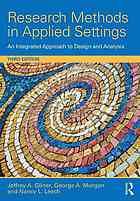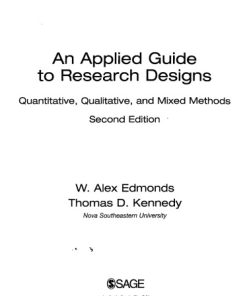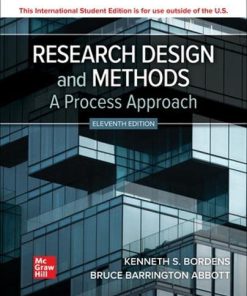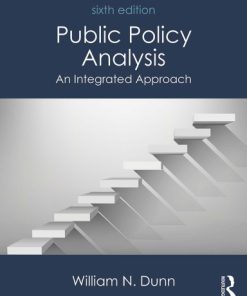Research methods in applied settings an integrated approach to design and analysis 3rd Edition by Jeffrey Gliner, Nancy Leech, George Arthur Morgan 113885297X 9781138852976
$50.00 Original price was: $50.00.$25.00Current price is: $25.00.
Research methods in applied settings an integrated approach to design and analysis 3rd Edition by Jeffrey A. Gliner, Nancy L. Leech, George Arthur Morgan – Ebook PDF Instant Download/DeliveryISBN: 113885297X, 9781138852976
Full download Research methods in applied settings an integrated approach to design and analysis 3rd Edition after payment.

Product details:
ISBN-10 : 113885297X
ISBN-13 : 9781138852976
Author: Jeffrey A. Gliner, Nancy L. Leech, George Arthur Morgan
This text teaches readers how to plan, conduct, and write a research project and select and interpret data through its integrated approach to quantitative research methods. Although not a statistics book, students learn to master which technique to use when and how to analyze and interpret results, making them better consumers of research. Organized around the steps of conducting a research project, this book is ideal for those who need to analyze journal articles. With teaching experience in various departments, the authors know how to address the research problems faced by behavioral and social sciences students. Independent sections and chapters can be read in any order allowing for flexibility in assigning topics.
Adopters applaud the book’s clarity and applied interdependent approach to research. The book emphasizes five research approaches: randomized experimental, quasi-experimental, comparative, associational, and descriptive. These five approaches lead to three kinds of research designs which lead to three groups of statistics with the same names. This consistent framework increases comprehension while avoiding confusion caused by inconsistent terminology. Numerous examples, diagrams, tables, key terms, key distinctions, summaries, applied problems, interpretation questions, and suggested readings further promote understanding.
Research methods in applied settings an integrated approach to design and analysis 3rd table of contents:
1 Definitions, Purposes, and Dimensions of Research
Definitions of Research
Purposes of Research
Research Dichotomies
Research Types or Approaches
Summary
Key Concepts
Key Distinctions
Different Terms for Similar Concepts
Interpretation Questions
Application Problems
Notes
2 Planning a Quantitative Research Project
Overview of the Steps in the Research Plan
Research Problems
Review of the Literature
Summary
Key Concepts
Key Distinctions
Interpretation Questions
Application Problems
Quantitative Research Approaches, Questions, and Designs
3 Variables, Research Questions, and Hypotheses
Variables
Research Hypotheses and Questions
Framework for Stating Research Questions/Hypotheses
Summary
Key Concepts
Key Distinctions
Interpretation Questions
Application Problems
Notes
4 Research Approaches
Overview of the Research Approaches
Research Approaches with an Active Independent Variable
Research Approaches with Attribute Independent Variables
Summary
Key Concepts
Key Distinctions
Interpretation Questions
Application Problems
5 Randomized Experimental and Quasi-Experimental Designs
Design Terminology
Quasi-Experimental Designs with Major Limitations
Better Quasi-Experimental Designs
Time-Series Designs
Randomized Experimental Designs
Summary
Key Concepts
Key Distinctions
Interpretation Questions
Application Problems
Notes
6 Single-Subject Designs
Reversal Designs
Multiple-Baseline Designs
Alternating Treatment Designs
Measurement and Data Analysis
Generalization and Meta-Analysis of Single-Subject Designs
Summary
Key Concepts
Key Distinctions
Interpretation Questions
Application Problems
7 Nonexperimental Approaches/Designs
Quantitative Nonexperimental Research Approaches
An Expanded View of the Five Quantitative Approaches
Qualitative Nonexperimental Research Approaches
Summary
Key Concepts
Key Distinctions
Interpretation Questions
Application Problems
Notes
8 Internal Validity
Identifying Causal Relationships
Evaluating Internal Validity
Traditional Threats to Internal Validity
Summary
Key Concepts
Key Distinctions
Interpretation Questions
Application Problems
Sampling, Measurement, and Data Collection
9 Sampling and Intr@duction to External Validity
What Is Sampling?
Sampling Designs
How Many Participants?
External Validity
Sampling and the Internal and External Validity of a Study
Summary
Key Concepts
Key Distinctions
Different Terms for Similar Concepts
Interpretation Questions
Application Problems
10 Measurement and Descriptive Statistics
Overview of the Normal Curve
Measurement
Descriptive Statistics and Graphs
More on the Normal Curve
Levels of Measurement and Descriptive Statistics
Summary
Key Concepts
Key Distinctions
Interpretation Questions
Application Problems
Notes
11 Measurement Reliability
Measurement Reliability
Methods to Assess Measurement Reliability
Summary
Key Concepts
Key Distinctions
Interpretation Questions
Application Problems
Notes
12 Measurement Validity
Validity in the 1985 Standards for Educational and Psychological Testing
Validity in the 1999 Standards for Educational and Psychological Testing
Evaluation of Measurement Validity
Summary
Key Concepts
Key Distinctions
Interpretation Questions
Application Problems
13 Types of Data Collection Techniques
Overview
Standardized Versus Investigator-Developed Instruments
Researcher-Observed Measures
Tests and Documents
Self-Report Measures
Summary
Key Concepts
Key Distinctions
Interpretation Questions
Application Problems
14 Ethical Issues in Conducting the Study
Ethical Principles in Human Research
Ethical Issues in the Sample Selection
Ethical Issues and the Methods Section
Approval from the Institutional Review Board
Ethical Issues with Regard to the Data Collection
Summary
Key Concepts
Key Distinctions
Interpretation Questions
Application Problems
15 Practical Issues in Data Collection and Coding
Initial Steps in the Research Process
Data Coding, Entry, and Checking
Data Reduction: Applying Measurement Reliability and Validity
Summary
Key Concepts
Key Distinctions
Interpretation Questions
Application Problems
Data Analysis and Interpretation
16 Making Inferences from Sample Data I: The Null Hypothesis Significance Testing Approach
An Example
The Null Hypothesis (H0) and Alternative Hypotheses (H1)
The Inferential Process
Understanding and Assessing Statistical Power
Problems with Null Hypothesis Significance Testing
Improvements to NHST
Summary
Key Concepts
Key Distinctions
Interpretation Questions
Application Problems
Notes
17 Making Inferences from Sample Data II: The Evidence-Based Approach
Problems with Considering Only a Single Study
Confidence Intervals
Effect Sizes
Meta-Analysis
Summary
Key Concepts
Key Distinctions
Interpretation Questions
Application Problems
18 General Design Classifications for Selection of Difference Statistical Methods
General Design Classifications
More Design Considerations
Diagramming Designs
Describing the Various Types of Design
Design Classifications of Specific Research Designs
Summary
Key Concepts
Key Distinctions
Interpretation Questions
Application Problems
Notes
19 Selection of Appropriate Statistical Methods: Integration of Design and Analysis
Review of Concepts Necessary for Selecting Inferential Statistics
Selection of Appropriate Inferential Statistics
The General Linear Model
Summary
Key Concepts
Key Distinctions
Different Term for Similar Concept
Interpretation Questions
Application Problems
Notes
20 Data Analysis and Interpretation: Basic Difference Questions
Analyzing Single-Factor (Between-Groups) Designs with Parametric Statistics
Analyzing Single-Factor (Between-Groups) Designs with Nonparametric Statistics
Analyzing Single-Factor Repeated-Measures Designs with Parametric Statistics
Analyzing Single-Factor Within-Subjects Designs with Nonparametric Statistics
Advantages and Disadvantages of Within-Subjects Designs
Summary
Key Concepts
Key Distinctions
Interpretation Questions
Application Problems
21 Analysis and Interpretation of Basic Associational Research Questions
Analyzing Continuous Variables with Parametric Statistics
Using Nonparametric Associational Statistics
Misleading Correlation Coefficients
Associational Statistics for Nominal Variables
Summary
Key Concepts
Key Distinctions
Interpretation Questions
Application Problems
Notes
22 Analysis and Interpretation of Complex Research Questions
Analysis and Interpretation of Complex Difference Questions
Analysis and Interpretation of Complex Associational Questions
Summary
Key Concepts
Key Distinctions
Interpretation Questions
Application Problems
Note
Evaluating and Writing Research Reports
23 Evaluating Research Validity: Part I
A Framework for Evaluating Research Validity
Analysis of the Design and Methods
Evaluation of the Four Key Dimensions of Research Validity
Summary
Key Concepts
Key Distinctions
Interpretation Questions
Application Problems
24 Evaluating Research Validity: Part II
Overall Measurement Validity of the Constructs
External Validity
Population External Validity
Ecological External Validity
Other Issues
The Relative Importance of Different Validity Dimensions
Summary
Key Concepts
Key Distinctions
Interpretation Questions
Application Problems
25 Evaluating Research for Evidence-Based Practice
Levels of Evidence
Problems with the Use of Levels of Evidence Hierarchies
The Process of Evidence-Based Practice
Summary
Key Concepts
Key Distinctions
Interpretation Questions
Application Problems
26 Writing the Research Report
The Anatomy of a Research Article
Ethical Issues Related to Publishing and Reviewing
Summary
Key Concepts
Key Distinctions
Interpretation Questions
Application Problems
People also search for Research methods in applied settings an integrated approach to design and analysis 3rd:
research methods in applied settings
what are mixed methods approaches
what is approach in research methodology
when to use a mixed methods approach
research methods in ap research
Tags: Research methods, settings, integrated approach, Jeffrey Gliner, Nancy Leech, George Arthur Morgan
You may also like…
Politics & Philosophy - Social Sciences
dictionaries & phrasebooks
An Integrated Approach To Communication Theory And Research Don 1351358707 9781351358705
Business & Economics - Management & Leadership
Threat assessment and risk analysis : an applied approach 1st Edition Allen
Politics & Philosophy - Social Sciences
Education Studies & Teaching - Educational Theory
Research Design and Methods: A Process Approach 11th Edition by Bordens 1264169639 9781264169634
Politics & Philosophy - Social Sciences
Public Policy Analysis An Integrated Approach 1st edition by William Dunn 1351721684 9781351721684












